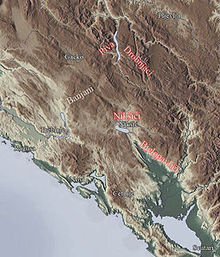Serb Uprising of 1596–97
| Serb Uprising of 1596–97 | |||||||
|---|---|---|---|---|---|---|---|
| Part of the Long Turkish War | |||||||
 Map showing the revolting tribes and key towns |
|||||||
|
|||||||
| Belligerents | |||||||
| Bjelopavlići, Drobnjaci, Nikšići and Pivljani (tribes) | Ottoman Empire | ||||||
| Commanders and leaders | |||||||
|
Grdan Organized by Visarion and Jovan Kantul |
Dervish Bey | ||||||
The Serb Uprising of 1596–97 was a rebellion organized by Serbian Patriarch Jovan Kantul (s. 1592–1614) and led by Grdan, the vojvoda ("duke") of Nikšić against the Ottomans in the Sanjak of Herzegovina and Montenegro Vilayet, during the Long Turkish War (1593–1606). The uprising broke out in the aftermath of the failed Banat Uprising in 1594 and the burning of Saint Sava's relics on April 27, 1595; it included the tribes of Bjelopavlići, Drobnjaci, Nikšić and Piva. The rebels, defeated at the field of Gacko (Gatačko Polje) in 1597, were forced to capitulate due to a lack of foreign support.
In early 1594, the Serbs in Banat rose up against the Ottomans. The rebels had, in the character of a holy war, carried war flags with the icon of Saint Sava. The war banners were consecrated by Patriarch Jovan Kantul, and the uprising was aided by Serbian Orthodox metropolitans Rufim Njeguš of Cetinje and Visarion of Trebinje (s. 1590–1602). In response, Ottoman Grand Vizier Koca Sinan Pasha demanded that the green flag of the Prophet Muhammed be brought from Damascus to counter the Serb flag and ordered that the sarcophagus containing the relics of Saint Sava be removed from the Mileševa monastery and transferred to Belgrade via military convoy. Along the way, the Ottoman convoy killed all the people in its path as a warning to the rebels. The Ottomans publicly incinerated the relics of Saint Sava on a pyre atop the Vračar plateau on April 27, 1595, and had the ashes scattered.
...
Wikipedia
